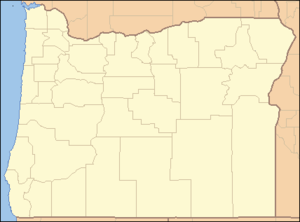Molalla River
| Molalla River | |
|
Molalla River
|
|
| Name origin: After the Molala people | |
| Country | United States |
|---|---|
| State | Oregon |
| County | Clackamas |
| Source | Table Rock Wilderness Area |
| - location | Cascade Range |
| - elevation | 3,304 ft (1,007 m) |
| - coordinates | 44°54′12″N 122°16′01″W / 44.90333°N 122.26694°W |
| Mouth | Willamette River |
| - location | Molalla River State Park |
| - elevation | 69 ft (21 m) |
| - coordinates | 45°17′23″N 122°43′18″W / 45.28972°N 122.72167°WCoordinates: 45°17′23″N 122°43′18″W / 45.28972°N 122.72167°W |
| Length | 51 mi (82 km) |
| Basin | 874 sq mi (2,264 km2) |
| Discharge | for river mouth |
| - average | 2,377 cu ft/s (67 m3/s) |
The Molalla River is a 51-mile (82 km) tributary of the Willamette River in the northwestern part of Oregon in the United States. Flowing northwest from the Cascade Range through Table Rock Wilderness, it passes the city of Molalla before entering the larger river near Canby. The Molalla is the largest Willamette tributary unblocked by a dam.
The river's headwaters are in Clackamas County, near the Table Rock Wilderness, in the Cascade Range. Flowing generally north-northwest from the mountains, the river enters the Willamette Valley and flows past the city of Molalla. It is joined by the Pudding River shortly before entering the Willamette near the city of Canby. The confluence is about 36 miles (58 km) from the Willamette's mouth on the Columbia River. The Molalla River is the largest free-flowing tributary of the Willamette.
Named tributaries from source to mouth are Henry, Ogle, Mining Iron, Lake, Scorpion, Hay Barn, Minnette, Dungeon, Avalanche, and Bull creeks, followed by Table Rock Fork. Below that are Horse, Gawley, Cow, Bear, Shotgun, Pine, and Trout creeks followed by the North Fork Molalla River. Then come Russell, Cedar, Dickey, Woodcock, Milk, and Gribble creeks, then the Pudding River.
The average discharge of the river at the mouth is 2,377 cubic feet per second (67.3 m3/s). Above the confluence with the Pudding River, the average discharge is 1,142 cubic feet per second (32.3 m3/s), about half of the flow at the mouth.
During the early 19th century, the area around the river was populated by the Molala people. During that time, an extensive system of trails along the river allowed trade between the peoples of the Willamette Valley and eastern Oregon. As late as the 1920s, the trails were used by Native Americans from the Warm Springs Indian Reservation to reach huckleberry-picking grounds near Table Rock.
...
Wikipedia


